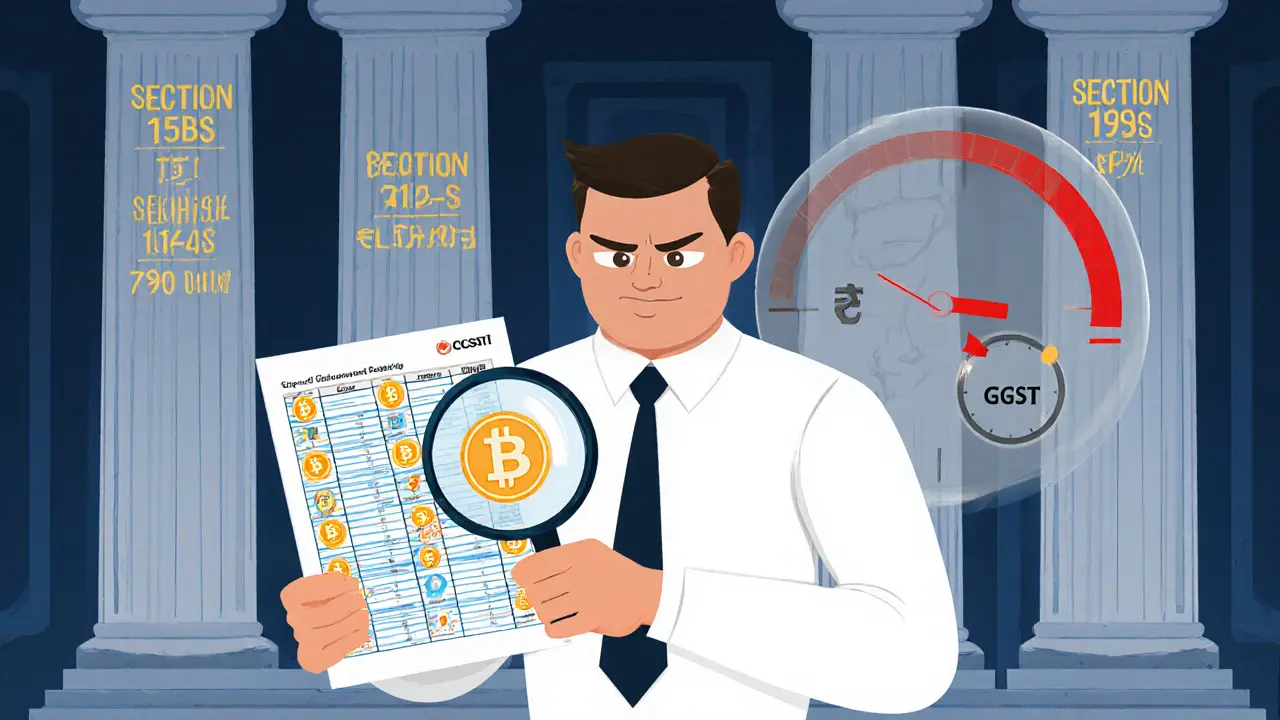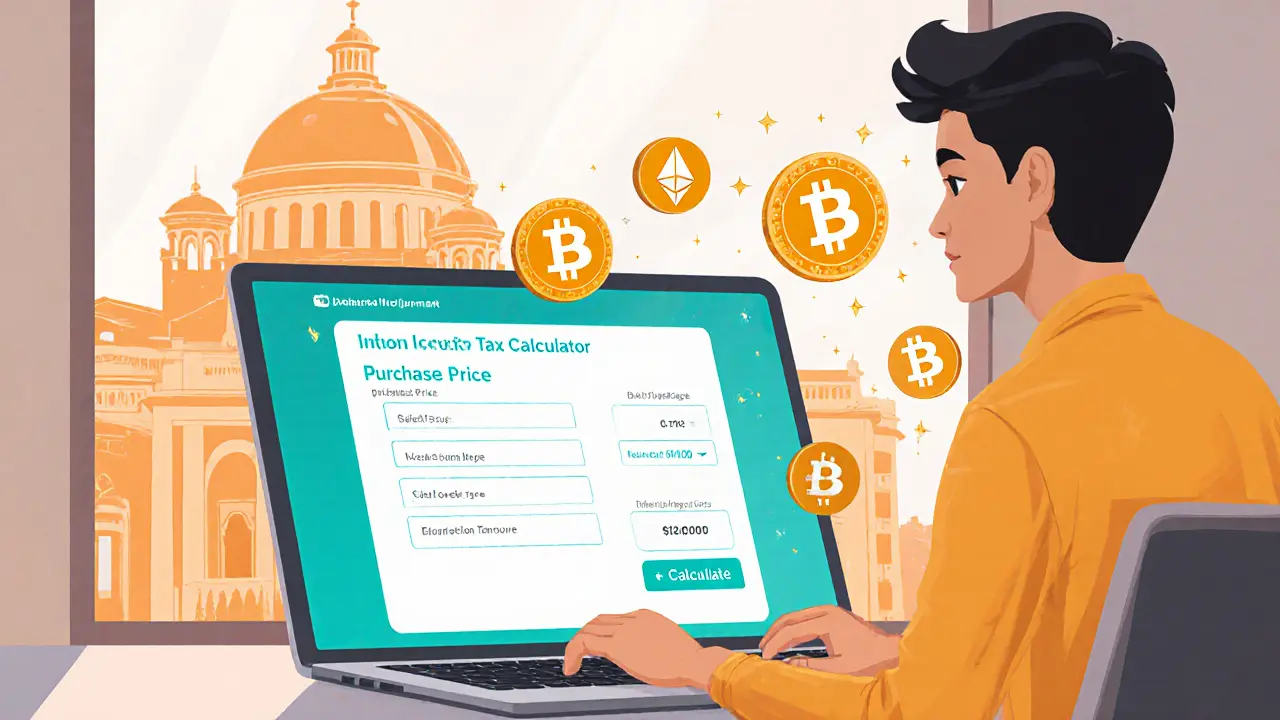Crypto Tax Calculator 2025
Your Tax Calculation Summary
- Gain Amount: ₹0
- Taxable Gain (30% Flat Rate): ₹0
- TDS Deducted (1%): ₹0
- GST Applicable (18% on Sale): ₹0
- Total Tax Liability: ₹0
When we talk about crypto tax enforcement in India is the set of rules, reporting duties, and penalty mechanisms the government uses to make sure cryptocurrency earnings are declared and taxed correctly. Since the 2022‑23 financial year, the framework hinges on Section 115BBH of the Income Tax Act, a flat 30% levy on all gains from Virtual Digital Assets (VDAs). The enforcement picture also involves Section 194S (1% Tax‑Deducted‑At‑Source), an 18% Goods and Services Tax (GST) on platform services introduced in July2025, and a slew of filing requirements that every trader or service provider must follow.
Quick Takeaways
- Flat 30% tax on crypto gains - no loss offset, no exemptions.
- Buyers must deduct 1% TDS on each transaction and remit it to the government.
- From 7July2025, crypto platforms charge 18% GST on all services, regardless of turnover.
- Non‑compliance can trigger income‑tax penalties up to ₹5Lakhs, GST fines, and interest on unpaid TDS.
- Report crypto income on ITR‑2 (capital‑gain) or ITR‑3 (business) using the dedicated ScheduleVDA.
Core Tax Structure
The 30% rate under Section 115BBH treats a VDA like a lottery win - you calculate the gain as SalePrice minus CostPrice, then apply the flat tax. There is no provision to carry forward crypto losses, nor can you offset them against other income. This makes the regime one of the toughest globally.
On top of that, every crypto sale triggers a 1% TDS under Section 194S. The buyer (or exchange acting as buyer) must withhold the amount at the point of settlement and deposit it with the tax department using Form26Q. Failure to deduct TDS makes the buyer liable for the tax, plus interest and penalty.
Effective 7July2025, the government slapped an 18% GST on all services a crypto platform provides to Indian users - spot trading, margin trading, staking fees, withdrawals, deposits, and even custodial services. Platforms are now classified as OIDAR (Online Information and Database Access or Retrieval) services and must register for GST irrespective of the usual ₹20Lakh turnover threshold.
Compliance Requirements
For individuals, the income must be declared in the appropriate Income Tax Return:
- ITR‑2: Use when crypto activity is treated as capital‑gain (holding periods >36months qualify for long‑term rates, but the 30% flat still applies).
- ITR‑3: Use when you run a crypto‑trading business or provide services (e.g., staking, mining) that qualify as business income.
Both returns now contain a custom ScheduleVDA where you list each transaction - date, asset, purchase price, sale price, and tax withheld. The forms also ask for GST details if you’re a platform or service provider.
Crypto exchanges operating in India must:
- Register under GST as an OIDAR service.
- Issue GST invoices for every fee charged.
- Maintain transaction logs for at least six years, ready for audit.
- Deduct and remit 1% TDS on each trade, filing quarterly returns.
Penalty Landscape
While the government hasn’t published a stand‑alone crypto‑penalty schedule, the existing tax and GST statutes apply. Below is a snapshot of the typical fines you could face if you slip up.
| Violation | Relevant Law | Penalty | Notes |
|---|---|---|---|
| Failure to deduct TDS (1% on trade) | Section 194S & Section 271A | Up to ₹25,000 per default + interest | Buyer becomes liable for tax + penalty. |
| Late filing of crypto income | Section 234F | ₹5,000 (if ≤3months late) or ₹10,000 (if >3months) | Applies to both ITR‑2 and ITR‑3. |
| Under‑reporting of crypto gains | Section 271(1) | 10-200% of tax evaded (minimum ₹10,000) | Depends on the quantum of tax avoided. |
| Non‑payment of GST on platform services | CGST Act, Section 74 | 18% interest + ₹10,000 per default notice | GST arrears attract compound interest. |
| Failure to maintain records (6‑year audit trail) | Income Tax Rules, Section 44AB | ₹2,500 per day of non‑compliance up to ₹5Lakhs | Audits become difficult without logs. |
Besides monetary fines, persistent offenders may face prosecution under the Income Tax Act, leading to imprisonment of up to two years. The Central Board of Direct Taxes (CBDT) can also issue search and seizure orders for non‑cooperative exchanges.

Common Pitfalls & How to Dodge Them
- Ignoring TDS on peer‑to‑peer trades. Even if you trade on a decentralized exchange, the law expects the counterparties to deduct TDS. Use a compliant platform to avoid the default liability.
- Assuming loss offsets are allowed. The 30% regime does not let you carry forward crypto losses. Treat each trade as a fresh taxable event.
- Mixing personal and business accounts. If you provide staking or mining services, file ITR‑3 as business income; otherwise, you’ll be flagged for misclassification.
- Skipping GST registration. The July2025 rule forces every crypto platform to register, even with turnover less than ₹20Lakhs. Late registration triggers penalty under the CGST Act.
- Neglecting the ScheduleVDA. Skipping this section triggers a ‘non‑disclosure’ notice, which the CBDT treats as under‑reporting.
Recent Developments (2025)
In August2025, the CBDT circulated a detailed questionnaire to every Indian crypto exchange. Topics included the feasibility of a comprehensive crypto law, the practicality of the 1% TDS, and whether offshore platforms enjoy an unfair edge. The consultation signals that the government may soften the current tax regime or introduce a dedicated crypto legislation that could reshape enforcement.
The GST expansion earlier this year also means that platform‑level compliance is no longer optional. Exchanges that fail to issue proper GST invoices risk being black‑listed from the banking system.
Practical Compliance Checklist
- Calculate every trade’s gain (saleprice−costprice) and apply the 30% flat tax.
- Ensure the buyer deducts 1% TDS and deposits it using Form26Q within the due date.
- Record transaction details (date, asset, amount, counterparties) in a spreadsheet or accounting software.
- File ITR‑2 or ITR‑3 with ScheduleVDA before the July31 deadline.
- If you run a platform, register for GST, issue GST invoices, and file monthly GST returns.
- Maintain all records for at least six years; back‑up in secure cloud storage.
- Monitor CBDT updates - any change to the 30% tax or TDS rates will affect future filings.
What’s Next for Taxpayers?
Stay alert for the outcome of the CBDT’s August2025 consultation. If a new crypto law emerges, it could replace the flat 30% tax with a tiered system or introduce loss‑set‑off provisions. Until then, treat the current rules as binding and plan your trades accordingly.
If you’re unsure about your filing status, consider consulting a chartered accountant familiar with crypto. A small advisory fee now can save you from costly penalties later.
Frequently Asked Questions
Do I have to pay tax on crypto held in a foreign wallet?
Yes. The Indian tax authority taxes worldwide income. You must disclose the fair market value of crypto in foreign wallets on ScheduleVDA and apply the 30% rate, even if the exchange is offshore.
What happens if I forget to deduct the 1% TDS?
The buyer becomes liable for the tax, plus a ₹25,000 penalty and interest on the delayed amount. The buyer can also claim a credit if they later pay the tax, but it adds paperwork.
Can I offset crypto losses against salary income?
No. The 30% flat tax rule does not allow loss set‑off - neither against other crypto gains nor against any other income.
Is GST applicable to decentralized exchanges (DEXs)?
If a DEX provides any chargeable service to an Indian user (e.g., a bridge fee), GST applies. However, enforcement is challenging, and the tax department is focusing on centralized platforms first.
What records should I keep for audit purposes?
Maintain a ledger that captures transaction date, crypto asset, quantity, purchase price (INR), sale price (INR), counter‑party details, TDS certificates (Form16A), and GST invoices. Back‑up the ledger digitally for six years.












People Comments
The recent guidance on crypto taxation in India underscores the importance of diligent record‑keeping and proactive compliance. Taxpayers should adopt a systematic approach to calculating gains, ensuring that the 30 % flat rate is applied correctly to each transaction. Moreover, the mandatory 1 % TDS and the newly introduced 18 % GST require timely remittance to avoid penalties. By integrating these obligations into a comprehensive financial plan, investors can mitigate the risk of punitive action. Ultimately, disciplined adherence to the Schedule VDA will foster confidence in the evolving regulatory environment.
Honestly, all this hype about the 30 % flat tax feels like the government just wants to scare us off crypto entirely. Who cares about a tiny 1 % TDS when the real pain is the 18 % GST eating your platform fees. If you’re clever, you’ll find ways around it, like using offshore DEXes that the tax man can’t touch. In short, the rules are overblown, not a reason to quit trading.
Hey folks, just a quick tip – keep a simple spreadsheet where you log every buy and sell, the INR amount, and the date. That way the ScheduleVDA fills itself and you won’t miss the 1% TDS or the GST invoice. Also, don’t forget to save the Form16A you get after the exchange deducts the TDS; it’s proof for your return. If you’re using a crypto app, many now export CSV files you can import. Trust me, this saves a lot of night‑mare when filing your ITR‑2 or ITR‑3.
Yo, crypto fam! The new tax rules might look rough, but think of them as a chance to tighten up your game. Grab a notebook or a digital ledger and record each trade – price, date, and counter‑party – right away. When the GST invoice lands, file it instantly, so you never scramble at year‑end. Remember, the 30 % flat rate applies no matter what, so factor it into your profit targets. Stay chill, stay organized, and the tax season will be a breeze!
The Indian government's recent imposition of a uniform thirty‑percent levy on cryptocurrency gains represents, in my view, a pivotal moment in the intersection of technology and fiscal policy; it is both a declaration of intent and a subtle invitation for stakeholders to adapt, evolve, and engage with the regulatory framework in a manner befitting the digital age. First, the flat rate eschews the complexities of progressive brackets, thereby simplifying calculation, yet simultaneously removes the nuanced opportunity for loss set‑off, a concession that many traditional investors might find disconcerting. Second, the mandatory one‑percent tax‑deducted‑at‑source, applicable on each transaction, introduces a layer of real‑time compliance that necessitates robust accounting practices, compelling traders to integrate tax considerations into their operational workflows from the moment a trade is executed. Third, the eighteenth‑percent Goods and Services Tax levied on platform services, effective July 2025, extends the tax net beyond mere capital gains, encompassing ancillary fees such as staking rewards, custodial charges, and even bridge fees on decentralized exchanges, thereby broadening the fiscal canvas upon which crypto activities are painted. Moreover, the requirement for exchanges to register under the OIDAR regime, regardless of turnover, signals a decisive shift towards formalization, eroding the once‑perceived anonymity that underpinned much of the sector's growth. This regulatory tide, while appearing onerous, offers a strategic advantage: it cultivates a transparent environment that may, in the long term, attract institutional participation, fostering liquidity and stability. Additionally, the Schedule VDA, a dedicated ledger within the income‑tax return, serves as a standardized conduit for reporting, streamlining audit processes and reducing discretionary interpretations of taxable events. In practice, diligent record‑keeping-capturing dates, asset identifiers, purchase and sale prices, and the corresponding TDS certificates-will not only ensure compliance but also empower taxpayers with clearer insights into their profit trajectories. From a macroeconomic perspective, the amalgamation of income tax, TDS, and GST revenues derived from crypto activities could contribute appreciably to the fiscal pool, aiding public expenditures and potentially financing further digital infrastructure. Critics may argue that the inflexible flat rate stifles innovation, yet the very act of taxation acknowledges the sector's legitimacy, embedding it within the nation's economic tapestry. For seasoned traders, the immediate implication is the necessity to recalibrate entry and exit strategies, factoring in the inevitable thirty‑percent deduction, alongside ancillary taxes, to preserve net profitability. Novice participants, on the other hand, must prioritize education on compliance, lest they fall prey to penalties that can ascend to lakhs of rupees, a financial burden far exceeding typical trading losses. In sum, the convergence of these tax mechanisms creates a comprehensive, albeit demanding, ecosystem that rewards foresight, meticulousness, and a proactive stance toward regulatory engagement. Ultimately, whether one perceives these measures as an impediment or an impetus for professionalization depends largely on one's willingness to adapt, innovate within the bounds of the law, and view taxation not merely as a cost but as a catalyst for sustainable growth in the digital asset arena.
The so‑called “comprehensive” regime is nothing but bureaucratic overreach; it burdens traders with redundant paperwork, inflates operational costs, and ultimately drives activity offshore. By imposing an unwieldy GST on every service, the tax code becomes a labyrinthine obstacle that only large entities can navigate. Furthermore, the flat thirty‑percent rate is arbitrarily high, disregarding market realities, and will inevitably lead to non‑compliance. In essence, the policy is a punitive instrument rather than a constructive framework.
While the concerns raised are certainly valid, it is important to recognize that a clear, unified tax structure does provide certainty for both investors and regulators; such transparency can facilitate better planning and reduce inadvertent errors. Moreover, the inclusion of GST aligns crypto services with other digital platforms, ensuring a level playing field. By adhering to the stipulated reporting mechanisms, taxpayers can mitigate the risk of severe penalties and contribute to the broader fiscal health of the nation. A collaborative approach between exchanges and authorities may further streamline compliance.
Great, another tax nightmare for crypto fans.
The moment we let the government tax our digital dreams, we betray the very spirit of freedom that crypto promised; it is a moral failing that we must resist, lest we surrender our autonomy to the state.
It is a misconception that foreign regulatory models should dictate India’s crypto policy; our sovereign fiscal framework must reflect national interests, and the current imposition of a uniform thirty‑percent tax, coupled with a one‑percent TDS and an eighteen‑percent GST, represents a balanced approach that safeguards fiscal integrity while encouraging domestic innovation.
When you think about tax as a reflection of how society values economic activity, the crypto tax regime forces us to ask whether digital assets are truly integrated into that societal contract or remain on the fringes, perpetually negotiating their legitimacy.
Keep those records tidy and the tax season will be a breeze 😊👍
Pay the tax, avoid the fine.